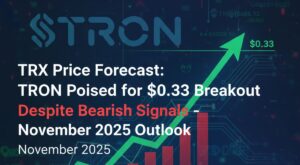The recent U.S. government shutdown has triggered a notable liquidity crunch across financial markets, including cryptocurrencies. According to a new macro analysis by HTX, the Treasury General Account (TGA) balance surged from around $800 billion to over $1 trillion, effectively removing nearly $200 billion from circulation. This liquidity drain has tightened funding conditions across the banking sector and impacted the flow of capital into digital assets.
Market Shifts and Asset Performance
In this evolving macro landscape, Bitcoin (BTC) is increasingly recognized as a foundational collateral asset, while Ethereum (ETH) continues to play a central role in transaction settlements. New investments are shifting toward areas such as Layer 2 networks, artificial intelligence (AI), robotics, and decentralized physical infrastructure (DePIN).
The report notes that the cryptocurrency market is currently in a structural bull phase—a phase of steady technological and economic expansion rather than a speculative rally. Investors are showing preference for assets with tangible value, proven scalability, and measurable growth potential, emphasizing functionality and innovation over pure price momentum.
Macroeconomic Insights
HTX’s findings suggest that the market is undergoing a “macro hand-off phase” rather than entering a downturn. After two years of aggressive post-pandemic fiscal stimulus, liquidity from the public sector is receding, allowing private markets to take a leading role in capital allocation. This transition favors assets built on real technological infrastructure and sustainable business models.
The global cryptocurrency market capitalization has now reached approximately $3.37 trillion, signaling a strong recovery from recent lows. Meanwhile, the Fear & Greed Index remains at 29, suggesting subdued investor confidence but also laying the groundwork for long-term accumulation.
Liquidity Adjustments and Sector Rotation
Although inflationary pressures are easing and the Federal Reserve’s “higher for longer” interest rate policy is beginning to lose intensity, the liquidity withdrawal following the government shutdown continues to pressure cyclical and high-risk assets.
Bitcoin’s volatility has decreased significantly as it transforms into a “risk-free” collateral foundation within the digital asset ecosystem—buoyed by growing institutional participation and ETF inflows. Ethereum, meanwhile, remains essential in channeling liquidity toward higher-risk, high-growth projects.
Emerging Investment Opportunities
The report identifies several emerging sectors poised for growth: advanced Layer 2 platforms, AI and robotics innovations, information finance (InfoFi), and memecoins. These areas offer rapid development, reduced transaction costs, and strong community-driven incentives. Additionally, presales are highlighted as a promising structural opportunity with notable upside potential.
Challenges and Future Outlook
Despite ongoing innovation, the crypto industry faces persistent hurdles, including regulatory ambiguity, on-chain complexity, and fluctuating market narratives. Still, the “structural bull” trend appears resilient—powered by synchronized cycles of technological advancement and financial innovation.
As the market evolves from a single-core ecosystem to a multi-core structure, sector rotation is expected to become a key driver of profitability. HTX concludes that future success in this cycle will depend on mastering the interaction between macroeconomic conditions, market narratives, liquidity management, and technological distribution.




























